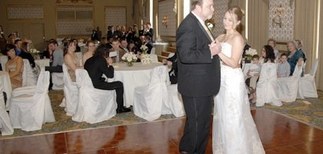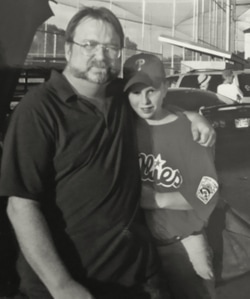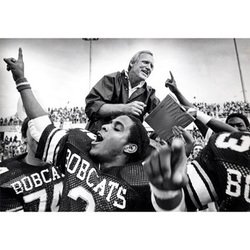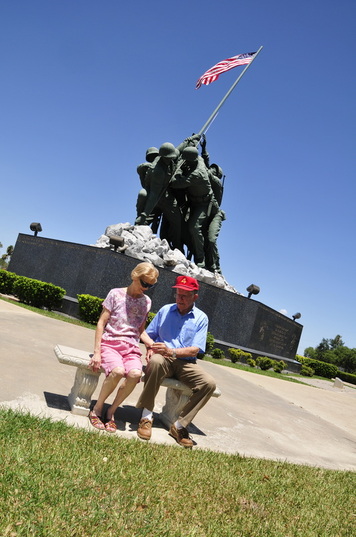His Life in WordsMark Hendricks
|
Maybe the Greatest Day Ever7/6/2009  The Pier At Hanalei Bay, North Shore, Kaua'i. The Pier At Hanalei Bay, North Shore, Kaua'i. by Mark Hendricks The semester before our 2009 trip to Kaua’i, Diana took a college astronomy course from Don Olson, a truly world-renowned astronomer on the Texas State faculty. Hawai’i is considered the most remote population center on the planet, meaning that – for a relatively large population – it is further away from a major land mass than any other. This remoteness makes it ideal for stargazing, and, in fact, the Big Island is home to one of the world’s most significant observatories. So, it seemed only natural that Diana would ask Don if there would be anything interesting in the sky for us to see when we were there in late May. And it was only natural that Don would be helpful and very happy to inform us that we would be there at the only time of year – late May – when the Southern Cross would be visible from the Hawaiian Islands. That particular constellation is usually only visible in the Southern Hemisphere, but Don assured us that there is a narrow window where it can be seen in the southern Hawaiian sky in late May. All you have to do is look in the southern sky after 9 p.m. or so and it should be there, slightly above the horizon. That would be easy for us as we were staying on the southern shore of Kaua’i. A simple look straight out at the ocean from the beach should give us a great view of the Cross. So we were disappointed that the first three nights, the southern sky was shrouded with cloud cover. The rest of the sky was perfectly clear and the stars were beautiful, but the southern exposure was non-existent. It would have been so easy for us to see it, too, because our balcony lanai faced directly south. It should have provided a perfect view for “Cross-gazing.” On the third night, though, I had about given up.
0 Comments
 (Photo by Melissa Millecam in New Orleans, LA, Jan, 17, 2009) - By Mark Hendricks (Written on the occasion of DeLynn's 18th birthday) ________________ OK, DeLynn: You tell me – where the heck have the past 18 years gone? When I wrote what was, until now, the last chapter of Father’s Forum back on July 18, 1984, you were only a few hours old. We were all still afraid of the Soviet Union and tormented by the presence of the Berlin Wall. We didn’t care about Saddam Hussein, and had never heard of Osama bin Laden. There were still Twin Towers in New York City. We had cassettes and videotapes instead of CDs and DVDs. Waylon was still with us, and I had no idea what he meant when he sang, “I look in the mirror in total surprise, at the hair on my shoulders and the age in my eyes.” But I do now, durnit. Little League's Lessons7/9/2006  By Mark Hendricks Patrick’s was a good team that year. Three or four star players. Several more who, like Patrick, were solid, steady and took well to good coaching. The brightest star on the team was Kevin. He could play any position. His glove was a vacuum cleaner on defense. On the mound, he threw nothing but strikes. He was a terrific hitter with a beautiful swing. And on the base paths, he was simply the fastest kid in the city. Kevin won ballgames for us that year. Several, in fact. Kevin had only one bad game all year. That was the same night Patrick had perhaps his best game ever. Patrick’s stars were aligned that night. The kid was everywhere. He was playing first and there were two on and two out. The batter hit a screaming liner well over his head, but ol’ Patrick’s cleats musta had wings that night. Michael Jordan in his prime may not have been able to get up for that ball, but, somehow, Patrick did. When he came down, he looked in his glove in disbelief. The ball was there. On the way to the dugout, his teammates whacked his butt, punched his shoulder, smacked the back of his head. Jeez, it must hurt to be a star, I thought. In The Beginning4/9/2006  Photo by Don Anders By Mark Hendricks (Hillviews, Spring 2006) We lost to Northern Iowa 40-37 in overtime on a frigid Friday night in December in San Marcos. Our Bobcats played their hearts out but, in the end, it just wasn’t enough. And that is how the season -- an otherwise glorious season -- ended. One game short of the national championship game. But this is not a story about how things end. It is a story about how things begin. A story about lessons we learn, hopes we rekindle, friends we make along the way. Ultimately, it is a story about pride, and about spirit. And maybe, just maybe, about one spirit in particular who smiles on us still. So how does the story of this incredible football season begin? With a win against Delta State? No, not really. A second-game blowout of Southern Utah? Nope. Strangely enough, the real beginning came with a loss. Not that loss to Northern Iowa or that heartbreaker to Nicholls State. But a loss to the mighty (well, they were considered pretty mighty then) Aggies of Texas A&M. Our second-year coach, David Bailiff, led our Bobcats into College Station to play a game most experts said shouldn’t even be played. We were, after all, a team with a 23-year history of ineptitude at the Division I-AA level. We had no business in Kyle Field. No business playing a team expected to contend for the Big 12 South. “Stay home, Bobcats, you’re out of your league,” they said. They were wrong. Sixty minutes of what Jim Wacker used to call “smash-mouth football” later, we ended up on the short end of a 44-31 score. But we had shown the Aggies, the Southland Conference and Bobcat Nation that we could play this game again. We had given the Aggies all they wanted and a couple of heaping tablespoons more. At the end of that game, there was one worn out team. One team that wanted out of Kyle Field. One team that had had enough. And that team was not our Bobcats. We were back. It's Early10/26/2003  Sunrise on Kaua'i. From: Mark Hendricks Date: Sun Oct 26, 2003 7:40:51 AM US/Central To: Diana Finlay Subject: It's early It's still fairly early this morning, so I probably haven't mentioned yet how deeply in love with you I am. Probably have neglected to say that you are on a pedestal that cannot be shaken or overturned. May have skipped my mind to tell you the passion you have brought to my life. But it's early. The time change has warped my sensibilities. So I probably forgot to say that you make me feel like some kinda damn superman, someone who may not, but now desperately wants to live forever. May not have gotten around to asking you just why in the heck I deserve this. But, if I do, I thank God. And you. As the day wears on, I suppose it'll dawn on me to tell you how your touch electrifies me, or calms me. And how you always seem to know which I need at that time. I'm still just only awake, so I may not have shared with you how delightful it is to laugh with you. How much I love your sense of humor. How wonderful it feels to just laugh out loud again. Have I told you yet today that you can make me cry? That I have tears in my eyes as I write this? Or how good that feels? Isn't it wonderful to know that tears can be caused by joy instead of pain? So many things I haven't told you yet today. But it's early. So forgive me if I haven't mentioned that your eyes melt my heart. That they sparkle. That you're beautiful. Have I ever told you that when I drive to your home, I start to feel kind of queasy and anxious the closer I get to you? Sort of like a high school kid on his way to a big date. And then when you answer your door, you wrap me in comfort, and the anxiety is only a distant memory. It's still early, so I may not have mentioned that there's a small conch shell on my dresser that I'm going to move back to my car today. Because I never notice it on my dresser. But when it was in my car, I couldn't miss it. And when I see it, I think of you. And I may not have told you yet today what a good thing that is. But it's early. And I love you. The Measure of a Man8/9/2003  Photo by Don Anders By Mark Hendricks (Hillviews) If you ever knew Jim Wacker, picture him in your mind’s eye for a moment. He’s smiling, isn’t he? Jim Wacker strode through life smiling. The legendary football coach who led the Bobcats to back-to-back NCAA Division II national championships in 1981 and 1982, died Aug. 26 at the age of 66 after a lengthy, courageous and often inspirational battle against cancer. Wacker coached the Bobcats from 1979 to 1982. His 42-8 record in that span is the highest winning percentage in school history. He also had collegiate head coaching jobs at Texas Lutheran (where he won consecutive NAIA national championships in 1974 and 1975), North Dakota State University, TCU and the University of Minnesota. He returned to Texas State to serve as director of athletics from 1998 to 2001. Although he won four national championships and virtually every national coaching award offered, the defining moment of Wacker’s career may have come while he was at TCU when he self-reported several NCAA violations that had occurred at the school before he arrived. That led to the most severe penalties ever imposed by the NCAA and set the TCU football program on its heels. Wacker stayed at TCU and eventually rebuilt the team into a winner again. The incident forever branded Wacker as a coach – and a man – of impeccable integrity. When she learned of his death, Texas State President Denise Trauth said, “Jim Wacker was an important part of the history of this university, but he was also so much more. He embodied our spirit and our enthusiasm. He was an inspirational leader not only to the players who played for him, but for all of us. He touched so many lives.” The measure of how many lives Wacker touched was demonstrated on Aug. 29 when his funeral service was held in Evans Auditorium on campus. So many former players, family members, colleagues and friends attended that the event was standing-room-only. Attendees were asked to park at Aquarena Center and rode shuttle buses to the service. The Rev. Roland Martinson conducted the funeral service and spoke of Wacker’s infectious enthusiasm. “Can you hear him?” Martinson asked. “Booming voice. Hearty laugh. He always spoke the way he walked. Can you hear him? Unbelieeeeevable! Amaaaaazing! You’ve GOT to be kidding! Some thought, ‘Was he for real?’” Oh, yes, Coach Wacker was for real. Measure the man by what was said of him on that day we remembered him. Measure him by the column inches devoted to his legend and the quotes from those who revered him. Iwo Jima: In Memory Of A Friend7/26/2001  By Mark Hendricks (Hillviews, 2011) Glen Cleckler ’50 and his wife JoAnn ’52 sit at the base of the Iwo Jima statue in Harlingen. One of the Marines depicted in the statue is Harlon Block, Glen’s friend who died on the island in 1945. From time to time, Glen Cleckler, 87, still visits his dear friend Harlon Block. He stands respectfully beside his gravesite. He may speak to him quietly, with a trace of a smile on his face, about the perils of growing old. But, for the most part, Cleckler uses these visits to remember. And on this sweltering summer afternoon on the campus of the Marine Military Academy in Harlingen, it is no different. Cleckler looks down upon his old friend’s resting place and remembers. The memories come easily, perhaps because they comprise a story that is so impossible to forget. The two were best friends in high school in the Rio Grande Valley town of Weslaco. They were young, handsome, athletic, and popular – teammates on a conference champion Weslaco High football team. Both seemed destined to play college ball. Cleckler, in fact, had a scholarship offer to Howard Payne. But one afternoon in the fall of their senior year of high school (1942-43), Block had a mischievous idea. It was an idea that would tip the first domino and start a sequence of events with consequences both tragic and heroic. About Mark
The child of a Marine Corps officer, Mark grew up on the move. A barefoot childhood on the beaches of Oahu, coming of age in the Commonwealth of Virginia, Mark made his way through five universities before settling in as a Texas State University Bobcat. He was a news, crime and sports reporter as well as news editor for the Laredo News, and served time at the San Marcos Daily Record. After a decade or so in the newspaper business, he went into higher education communications, and has spent almost a quarter-century back at Texas State, where he is now the Director of the University News Service. Archives
July 2009
Categories |
 RSS Feed
RSS Feed
